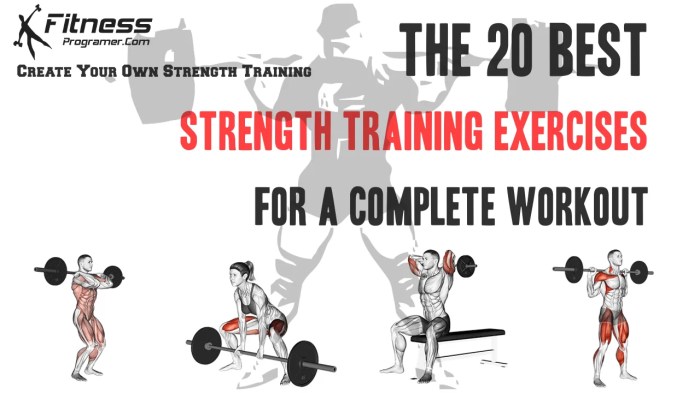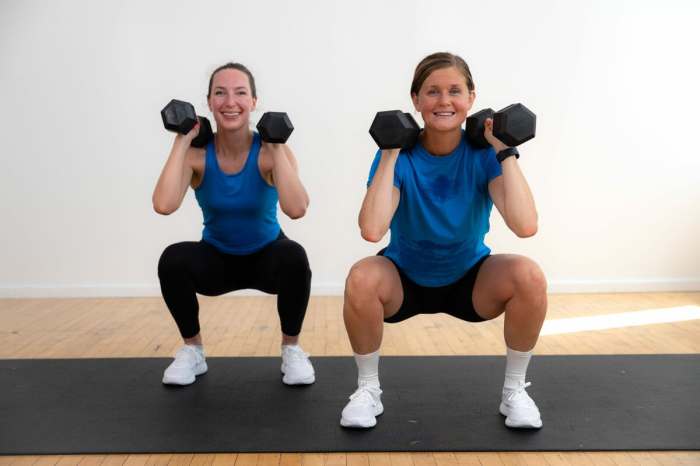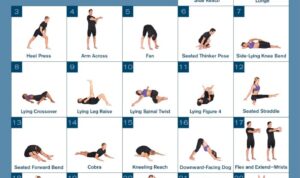Strength training exercises are the key to unlocking your full potential in fitness. From building muscle and burning fat to getting stronger and fitter, these exercises offer a wide range of benefits that can transform your body and health. Dive into the world of strength training and discover the power it holds for your fitness journey.
In this guide, we’ll explore the various types of exercises, proper form and technique, progression strategies, sample workouts, and the crucial role of nutrition and recovery in maximizing the results of your strength training routine. Get ready to sculpt your body, boost your performance, and elevate your fitness game with these strength training essentials.
Benefits of Strength Training Exercises
Strength training exercises are essential for anyone looking to improve their overall fitness level. Incorporating these exercises into your routine can have a multitude of benefits for your body and overall health.
Improved Muscle Tone
Strength training helps to increase muscle mass and definition, leading to improved muscle tone and a more sculpted physique. By challenging your muscles with resistance, you can achieve a leaner and more toned appearance.
Increased Bone Density
Engaging in regular strength training can also help to increase bone density, reducing the risk of osteoporosis and other bone-related conditions. The stress placed on the bones during strength exercises stimulates bone growth, making them stronger and less prone to fractures.
Boosted Metabolism
Strength training can rev up your metabolism, helping you burn more calories even at rest. Building muscle mass through strength exercises increases the body’s energy expenditure, leading to a higher metabolic rate and more efficient calorie burning.
Effective Weight Management
Incorporating strength training into your fitness routine can aid in weight management and fat loss. Muscle tissue burns more calories than fat tissue, so by increasing your muscle mass through strength exercises, you can boost your metabolism and enhance your body’s ability to burn fat.
Prevention of Injuries
Strength training helps to strengthen muscles, tendons, and ligaments, reducing the risk of injuries during physical activities. By building a strong foundation through strength exercises, you can improve your overall stability and minimize the likelihood of strains, sprains, and other injuries.
Types of Strength Training Exercises

When it comes to strength training, there are various types of exercises that can help you build muscle and improve your overall strength. These exercises can be categorized into bodyweight exercises, free weights, and resistance bands.
Compound Exercises, Strength training exercises
Compound exercises involve multiple joints and muscle groups working together. They are highly effective in building overall strength and muscle mass. Some common compound exercises include squats, deadlifts, and bench presses.
- Squats: Squats target the muscles in your legs, particularly the quadriceps, hamstrings, and glutes. They also engage your core for stability.
- Deadlifts: Deadlifts work the muscles in your lower back, hamstrings, glutes, and forearms. They are great for building strength and improving posture.
- Bench Presses: Bench presses primarily target the chest, shoulders, and triceps. They are essential for upper body strength and muscle development.
Isolation Exercises vs. Full-Body Exercises
Isolation exercises target specific muscle groups, while full-body exercises engage multiple muscle groups at once.
- Isolation Exercises: Examples of isolation exercises include bicep curls, tricep extensions, and calf raises. These exercises are great for targeting specific muscles and improving muscle definition.
- Full-Body Exercises: Full-body exercises like burpees, mountain climbers, and kettlebell swings engage multiple muscle groups simultaneously, providing a more efficient workout and improving overall functional strength.
Proper Form and Technique
Maintaining proper form and technique during strength training exercises is crucial to ensure maximum effectiveness and prevent injuries. Correct posture and alignment play a significant role in targeting the right muscles and avoiding strain on joints. Additionally, proper breathing techniques can enhance performance by providing the necessary oxygen to muscles during workouts.
Importance of Correct Posture and Alignment
- Keep your back straight and shoulders relaxed to avoid unnecessary strain on the spine.
- Engage your core muscles to stabilize your body and maintain balance throughout the exercise.
- Align your knees with your toes to prevent injuries and ensure proper muscle engagement.
- Focus on maintaining a neutral spine position to protect the lower back and improve overall posture.
Breathing Techniques for Enhanced Performance
- Exhale during the exertion phase of the exercise to help stabilize your core and maintain proper form.
- Inhale during the relaxation phase to replenish oxygen to your muscles and prepare for the next repetition.
- Avoid holding your breath, as it can increase blood pressure and limit the amount of oxygen delivered to your muscles.
- Practice rhythmic breathing patterns to synchronize your movements and optimize energy distribution.
Progression and Variation

Progression and variation are key elements in a successful strength training routine. By continuously challenging your muscles with progressive overload, you can stimulate muscle growth and strength gains over time. Incorporating variation in your exercises helps prevent plateaus and keeps your workouts exciting.
Progressive Overload for Muscle Growth
Progressive overload is the gradual increase in weight, reps, or intensity of your workouts to continually challenge your muscles. This is essential for muscle growth as it forces your muscles to adapt to new stress levels, leading to increased strength and size. Remember, muscles need to be consistently pushed beyond their current capacity to grow.
Methods for Progressing
- Increase Weight: Gradually add more weight to your exercises as you get stronger to ensure your muscles are continually challenged.
- Increase Reps: Increase the number of repetitions you perform for each exercise to push your muscles to fatigue and promote growth.
- Increase Intensity: Modify the intensity of your workouts by adjusting rest times, tempo, or incorporating supersets and drop sets.
Importance of Variation
Variation in exercises is crucial to prevent plateaus and boredom in your workouts. Changing up your exercises not only keeps your muscles guessing but also targets different muscle groups from various angles, leading to more balanced muscle development. Additionally, trying new exercises can help prevent overuse injuries and keep you mentally engaged in your fitness journey.
Sample Strength Training Workouts
When it comes to strength training workouts, it’s important to tailor the routine based on your fitness level and goals. Here are some sample workouts to help you get started and progress in your strength training journey.
Beginner Full-Body Workout
For beginners, a full-body workout is a great way to introduce your body to strength training. Perform each exercise with proper form and focus on mastering the movements before increasing weight.
- Squats – 3 sets of 10 reps
- Push-ups – 3 sets of 10 reps
- Rows – 3 sets of 10 reps
- Plank – 3 sets of 30 seconds
- Deadlifts – 3 sets of 10 reps
Intermediate to Advanced Split Routine
For intermediate to advanced individuals, a split routine allows you to target different muscle groups on different days, allowing for more intense workouts and better muscle recovery.
- Day 1: Chest and Triceps
- Bench Press – 4 sets of 8 reps
- Tricep Dips – 4 sets of 10 reps
- Day 2: Back and Biceps
- Pull-ups – 4 sets of 8 reps
- Barbell Curls – 4 sets of 10 reps
- Day 3: Legs
- Lunges – 4 sets of 12 reps
- Leg Press – 4 sets of 10 reps
Rest Periods and Frequency
Rest periods between sets should typically range from 30 seconds to 2 minutes, depending on the intensity of the exercise. Aim to strength train 3-4 times a week, allowing for at least one day of rest between sessions to allow for proper muscle recovery and growth.
Nutrition and Recovery: Strength Training Exercises
Proper nutrition and recovery are essential components for maximizing the benefits of strength training exercises. Nutrition plays a crucial role in supporting muscle growth and repair, while adequate rest is necessary for overall recovery and optimal performance.
Role of Nutrition in Muscle Growth and Recovery
Nutrition provides the building blocks necessary for muscle repair and growth after intense strength training sessions. Consuming an adequate amount of protein is crucial for repairing muscle tissue, while carbohydrates provide the energy needed for workouts and replenishing glycogen stores. Healthy fats are also important for hormone production and overall cellular function.
Pre-Workout and Post-Workout Meals Recommendations
– Pre-Workout: Aim for a balanced meal containing carbohydrates for energy, protein for muscle repair, and a small amount of healthy fats. Examples include a banana with almond butter, Greek yogurt with berries, or a turkey and avocado sandwich.
– Post-Workout: Focus on consuming a combination of protein and carbohydrates within 30 minutes to an hour after your workout. This can include a protein shake with fruit, grilled chicken with quinoa, or a tuna salad wrap.
Importance of Sleep and Rest for Recovery
Adequate sleep and rest are crucial for muscle repair and overall recovery after strenuous workouts. During sleep, the body releases growth hormone, which aids in muscle recovery and growth. Aim for 7-9 hours of quality sleep each night to optimize recovery and performance.

